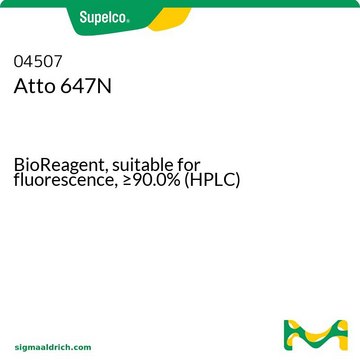推荐产品
一般說明
Abberior STAR RED is an already well known dye named also KK114 in literature (a scientific web search shows more than 60 publications, a selection is listed below). Please note the minimal background signal due to negligible unspecific binding. A key feature of the dye is its comparably long lifetime of ~3.5ns. The dye works exceptionally well with the Abberior Instruments STED microscope as well as with the Leica STED microscope.
Abberior STAR RED can substitute Atto™ 647N, AlexaFluor 647, or Cy®5. It can be excited with diode lasers (635 nm, 650 nm) or with the 647 nm line of a Krypton laser. For STED, a depletion wavelength around 750 nm is recommended. Please see reference [2] for detailed characteristics.
Best results are obtained with freshly prepared samples.
Abberior STAR RED can substitute Atto™ 647N, AlexaFluor 647, or Cy®5. It can be excited with diode lasers (635 nm, 650 nm) or with the 647 nm line of a Krypton laser. For STED, a depletion wavelength around 750 nm is recommended. Please see reference [2] for detailed characteristics.
Best results are obtained with freshly prepared samples.
應用
Abberior® STAR RED labelled cholesterol analogs were used for STED-FCS (stimulated emission depletion - fluorescence correlation spectroscopy) based measurements of membrane diffusion dynamics. Anti-mouse secondary antibody coupled to Abberior® STAR RED has been used for STED microscopy imaging in Vero cell line.
適合性
Designed and tested for fluorescent super-resolution microscopy
法律資訊
Atto is a trademark of Atto-Tec GmbH
Cy is a registered trademark of Cytiva
abberior is a registered trademark of Abberior GmbH
儲存類別代碼
11 - Combustible Solids
水污染物質分類(WGK)
WGK 3
閃點(°F)
Not applicable
閃點(°C)
Not applicable
Franziska Curdt et al.
Optics express, 23(24), 30891-30903 (2015-12-25)
Despite the need for isotropic optical resolution in a growing number of applications, the majority of super-resolution fluorescence microscopy setups still do not attain an axial resolution comparable to that in the lateral dimensions. Three-dimensional (3D) nanoscopy implementations that employ
Erdinc Sezgin et al.
Journal of lipid research, 57(2), 299-309 (2015-12-25)
Cholesterol (Chol) is a crucial component of cellular membranes, but knowledge of its intracellular dynamics is scarce. Thus, it is of utmost interest to develop tools for visualization of Chol organization and dynamics in cells and tissues. For this purpose
Daniel Neumann et al.
PMC biophysics, 3(1), 4-4 (2010-03-09)
The voltage-dependent anion channel (VDAC, also known as mitochondrial porin) is the major transport channel mediating the transport of metabolites, including ATP, across the mitochondrial outer membrane. Biochemical data demonstrate the binding of the cytosolic protein hexokinase-I to VDAC, facilitating
Christian Kukat et al.
Proceedings of the National Academy of Sciences of the United States of America, 108(33), 13534-13539 (2011-08-03)
Mammalian mtDNA is packaged in DNA-protein complexes denoted mitochondrial nucleoids. The organization of the nucleoid is a very fundamental question in mitochondrial biology and will determine tissue segregation and transmission of mtDNA. We have used a combination of stimulated emission
Roman Schmidt et al.
Nano letters, 9(6), 2508-2510 (2009-05-23)
Because of the diffraction resolution barrier, optical microscopes have so far failed in visualizing the mitochondrial cristae, that is, the folds of the inner membrane of this 200 to 400 nm diameter sized tubular organelle. Realizing a approximately 30 nm
我们的科学家团队拥有各种研究领域经验,包括生命科学、材料科学、化学合成、色谱、分析及许多其他领域.
联系技术服务部门

